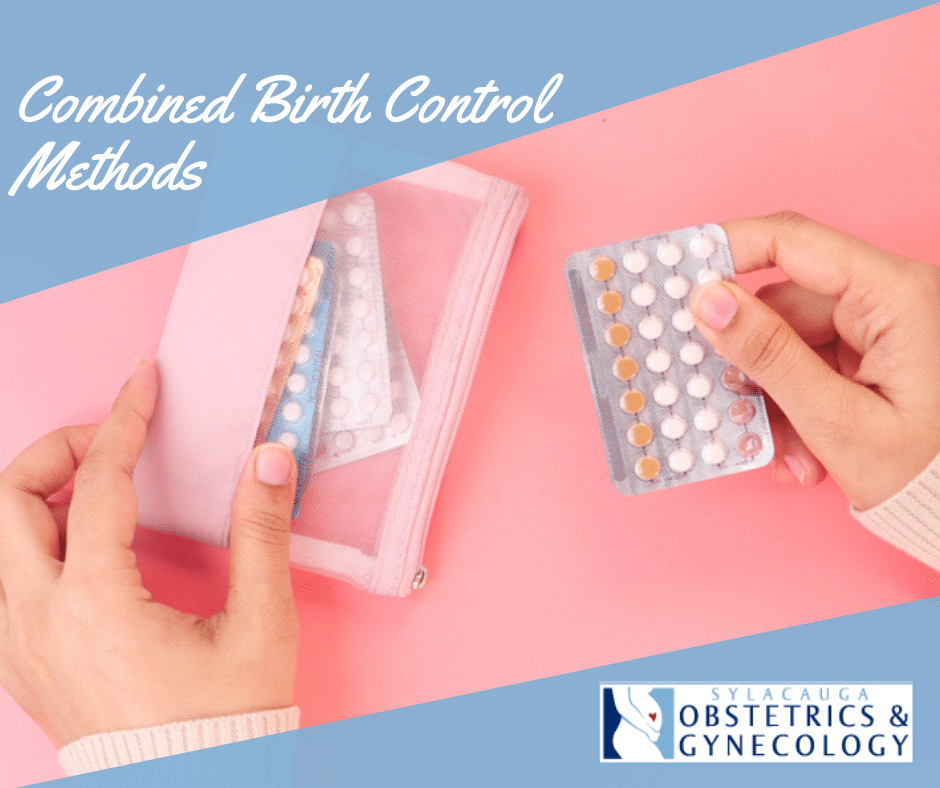
15 Mar What Are Combined Birth Control Methods?
At Sylacauga OB-GYN, we want to serve as your doctor through all stages of life, from the first appointment at the gynecologist in a young woman’s life, during pregnancy, and when the effects of menopause start taking place.
Throughout these many years, there’s a season for everything, and the progression is different for everyone. When one woman decides it’s time to try for a baby, it may be time for another woman to complete their childbearing years.
Depending on your stage of life, birth control may be a consideration, as it is for many couples. There are various options, and in this article we will cover combined birth control methods, including pills, the patch, and the vaginal ring.
What Are Combined Birth Control Methods?
Combined birth control methods, including pills, the patch, and the vaginal ring, prevent pregnancy by stopping ovulation. They also cause changes to occur in a woman’s body, which includes a thickening of the mucus in the cervix and a thinning of the uterine lining. These combined methods contain the hormones estrogen and progestin.
With perfect use of these methods, fewer than one out of every 100 women will get pregnant. But, perfect use rarely happens. When taken typically, which means the chosen method is not always used consistently or correctly, these methods prevent pregnancy in nine out of 100 women during the first year of use.
Of course, the primary reason to use birth control methods and the biggest benefit for most women is to prevent pregnancy. Some people aren’t aware that there are numerous other benefits to using combined birth control methods as well.
These include:
- Period and pain relief – Regular, consistent use of birth control reduces menstrual cramps and menstruation-related migraines. It also allows for a lighter, regulated, and shorter period.
- Reduction of cancer and other health problems – Birth control reduces the risk for cancer of the colon, uterus, and ovaries. It also helps reduce the occurrence of acne and unwanted hair growth.
- Treatment of certain disorders – These disorders include fibroids and endometriosis, which are known to cause heavy bleeding and menstrual pain.
Although birth control methods are safe for most women, risks can still occur. The risk of developing deep vein thrombosis (DVT) is higher when using birth control. Women also have a higher risk of developing this condition if they are above the age of 35; smoke more than 15 cigarettes a day; have a history of cardiovascular disease, high cholesterol, high blood pressure, or diabetes; history of stroke, heart attack, or DVT; or migraine headaches with aura.
Which Birth Control Method Is Right For You?
Birth control pills, a birth control patch, and a vaginal birth control ring all require a prescription before they can be administered to you. This means it will require you to come in for an appointment with one of our providers. At this appointment, we will talk with you and come up with a plan that suits you and your lifestyle best.
- Birth control pills – There are many different forms of birth control pills, from a 21-day subscription to a 365-day subscription, that can work for each individual. Many factors may go into deciding which one is best. Side effects of using birth control pills include nausea, headache, breast tenderness, and breakthrough bleeding, a temporary side effect that occurs from a change in hormone levels.
- Birth control patch – A contraceptive skin patch can be worn on the buttocks, chest (not in the breast area), abdomen, upper back, or arm. A patch is applied once a week for three weeks. On the fourth week, you’ll have your period. In order to be a continuous-dose birth control option, you will apply a new patch every week on the same day without skipping. Breast tenderness, skin irritation, headache, and breakthrough bleeding are side effects of using a contraceptive birth control patch.
- Vaginal ring – A vaginal ring is inserted by you into your vagina to control pregnancy. The ring remains in the vagina for 21 days, after which you will remove it and wait seven days before inserting a new ring. You cannot skip a week if you plan to use your vaginal ring as a form of continuous-dose birth control. Side effects of vaginal rings include headache, nausea, vaginal discharge/irritation, breakthrough bleeding, and breast tenderness.
Combined Birth Control Options at Sylacauga OB-GYN
No matter what form of birth control you choose, Sylacauga OB-GYN can walk you through what to expect with your choice. Read more about additional choices for birth control in this article from Dr. McInnis, and when the time comes to move into the next stage of life, we’ll be here to help you make that transition as well!
LEARN MORE ABOUT WHAT MAKES SYLACAUGA OBSTETRICS AND GYNECOLOGY A TOP PROVIDER
Sylacauga OB-GYN is the premier provider of obstetric and gynecological services in Sylacauga, Alexander City, Talladega, and the surrounding areas. From your first exam to your new little one’s delivery, our staff and providers are here to make your journey as smooth as possible. At Sylacauga Obstetrics & Gynecology, we are ready to answer your questions, provide support, and guide your process during your baby’s growth!
No need to drive to Birmingham to receive a superior quality of care for you and your impending bundle of joy. We are big town doctors with small-town care! Check out our website or give us a call at 256-487-9346 for more information or to schedule an appointment. For more information about healthy pregnancies, delivery options, and more, give us a call or email us at [email protected].


